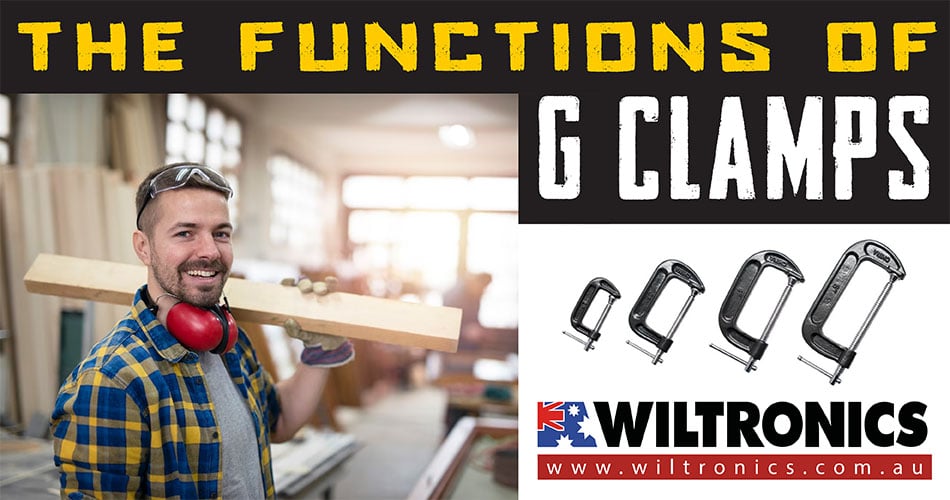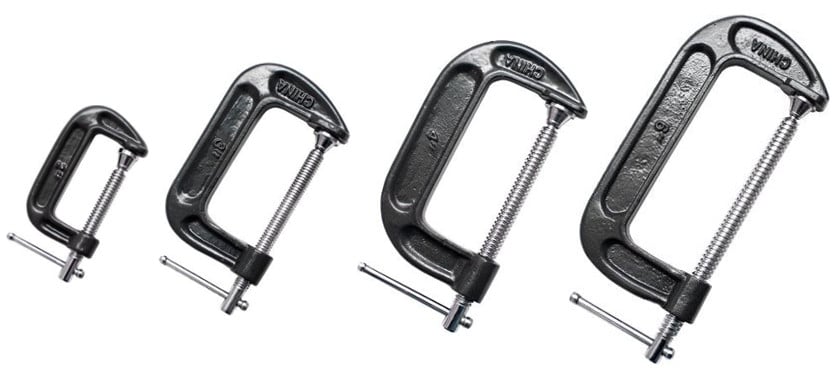Guide to Clamps: The Functions of G Clamps
March 29, 2023

G clamps are essential yet versatile tools for clamping and positioning objects. They come in handy for a variety of tasks, such as woodworking and general repairs.
This article will explore the various uses of G clamps. Along with their different types, sizes, advantages and disadvantages. Read on to learn how to use them the right way so that you can maximise their utility.
What Are G Clamps?
A G clamp is a type of metal fastening device used to join two or more workpieces together. It comprises two main parts: the fixed jaw and the screw mechanism.
The screw can be adjusted to the desired application size. Meanwhile, the fixed jaw remains stationary, providing stability and strength to the assembly.
G clamps are toolbox items commonly used in carpentry and metalworking, including:
- engineering
- framing
- and other applications where secure joints are required
They are also often used for holding objects in place temporarily. A great example is for soldering or welding.
Check out some G Clamps here:

G Clamp
This G Clamp is a heavy-duty, durable steel clamp. They are suitable for firmly securing an item to a bench or other flat surface. Available in 50mm, 75mm, 100mm and 150mm opening lengths.
Understanding the Mechanics: How Do G Clamps Work?
At its simplest, a G clamp has two main components – the fixed part and the screw part. The fixed part is shaped like a ‘C’ and is made of steel or cast iron. This forms the base upon which your object will be clamped. At one end of this fixed part, there is s a screw, which is adjusted to clamp the required object. This makes the clamp look like a ‘G’.
Using Your G Clamp
Using your g clamp is simple! Place it over your object, a piece of wood, for instance. Then, rotate the screw clockwise until pressure tightens around your workpiece.
Depending on the size and weight of your object, you may need more than one clamp to secure it firmly in position. Adjust each screw to tighten or loosen it until both sides are parallel. Make sure there is extra tension but no danger that anything can slip out!
Different Types of Clamps and Their Uses
Besides G clamps, other types are outlined below, including their applications:
Spring clamps
A spring clamp provides light clamping pressure. Its jaw usually has soft plastic or rubber pads to protect the object being clamped. It is also called a pinch clamp and features:
- two grippers
- two handles
- a spring pivot that connects the parts in the middle
Spring clamps are commonly used in woodworking and carpentry. They also make a good choice for a range of domestic tasks around the home, where larger clamps would be unfit.
F clamps
Like the G clamp, the name ‘F clamp’ comes from its F-shaped design. It features a long vertical bar and two smaller perpendicular jaws. F clamps are ideal for heavy-duty woodworking and are available in a range of different sizes.
Sash clamps
The design of a sash clamp features a flat bar with a fixed jaw, which can be adjusted with a screw action. It also has a sliding gripper locked in position along the bar. Sash clamps are mainly used for jobs involving large objects, such as doors or furniture.
Toggle clamps
A toggle clamp has one clamping plate and works with a work surface, e.g. a workbench. Unlike other types, it can be bolted into place and fixed permanently. At the same time, it can be adjusted to accommodate objects of various sizes.
Corner clamps
A corner clamp or right angle makes projects with 90° joints faster and easier. It holds the parts in place while giving a helping hand you need to hold other parts in position.
One of its arms features a steel pin that fits into a pocket hole. This allows for two objects or surfaces to be clamped together.
Pipe clamps
A pipe clamp has a similar design to a sash, except that it uses a round shaft instead of a flat bar. This enables the tool to reach any opening capacity.
Quick release clamps
Also known as a one-handed clamp, a quick-release clamp features a lever. This lever can release an object in one quick movement, hence the name of the tool. There are different styles available, including spring and trigger.
Band clamps
A band clamp or strap/web clamp has a strong nylon strap instead of metal grippers found in other types. This makes it ideal for gripping large or irregular-shaped items.
Common Applications of G Clamps
G Clamps can be used in a variety of applications, with their use limited only by your imagination! Here are some of the most common alongside wood- and metalworking:
Cabinet-making and joinery
If you are building furniture or carrying out any kind of joinery work, G clamps are an invaluable asset. From large cabinets to small drawers, using a G clamp will help keep everything aligned. At the same time, ensuring that all elements are securely fixed.
A G clamp can also be used in a wide range of positions without losing grip or pressure on the joints being worked on.
Repair work and building maintenance
G clamps also make a great solution not only for repair work but also for maintenance activities. A great example is components that need to be held firmly in place while glue and other bonding agents set.
The tool provides evenly distributed pressure across the surface area being worked on. This helps ensure that a secure bond is created between two or more elements.
Cutting and milling tasks
If you are cutting anything from wood to metal having a G clamp handy will make things much easier and safer! Using the tool will help ensure that wonky cuts do not occur when cutting. One, it holds everything firmly in place while still allowing you a full range of motion.
Car bodywork repairs
Do you enjoy repairing cars at home? Having access to a good quality G clamp is absolutely essential! Whether you are fixing up rust spots or patching up dents, it enables secure and accurate repairs. All that while giving you full control over each stage along the way.
No matter what size car panel you try to fix, these clamps offer enough grip power and flexibility.
The Bottom Line
G Clamps may look fairly basic, but they are super useful for all sorts of DIY applications. They are hand tools designed to bind or press two or more objects together, keeping them in place. They are effective for holding materials temporarily in most cases. For instance, wood, paper, plastic, or certain metals.
© Electrotech Brands Pty Ltd 2023


Write a Comment
You must be logged in to post a comment.